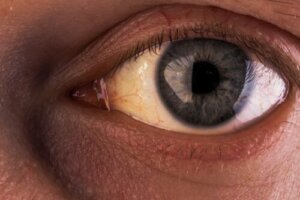Gilbert's Syndrome - Common but Unknown

Gastroenterologist Agustín Nicolás Gilbert first described Gilbert’s syndrome in 1901. He observed that certain patients had elevated levels of indirect bilirubin and, therefore, a yellowish tone in the skin and sclera of the eye. This is commonly referred to as jaundice.
These patients didn’t have any viral alterations, such as hepatitis, nor did they have obstructions of the bile ducts due to tumors. What happened is that, due to a genetic mutation, people with Gilbert’s syndrome had an absent liver enzyme known as glucuronosyltransferase.
This enzyme wasn’t present. Thus, it was impossible for them to properly metabolize bilirubin, a yellow pigment found in the bile and formed by the degradation of hemoglobin, just as it happens in the rest of the population. Therefore, their levels increased as a consequence.
“Hatred is one of the poisons; like jaundice, it alters the true colors of things.”
-Rae Foley-
Gilbert’s syndrome is common but unknown
This syndrome doesn’t have serious implications for a person’s life. Thus, it’s good to know it manifests as a series of extremely uncomfortable symptoms, even though it’s usually minimized. There’s also a significant association with emotional problems such as anxiety, depression, and obsessions.
Similarly, although not much is known, estimates indicate it affects five percent of the population and is more common in men than in women. Some people with this condition don’t know they have it until a routine blood test reveals it. Doctors usually diagnose it between the ages of 15 and 30.
In addition to these symptoms, today’s article will describe it in more detail. As a side note, bilirubin protects against other pathologies.
Studies reveal that bilirubin levels that are a bit higher than normal derive from an antioxidant that can prevent relevant pathologies, such as cancer. They also found that patients with Gilbert’s syndrome have more protection against cardiac problems. In addition, their blood pressure is lower.

The symptoms of Gilbert’s syndrome
It’s common to hear in doctor’s offices that Gilbert’s syndrome is asymptomatic. Actually, a significant percentage of patients feel misunderstood because this statement doesn’t correspond to their daily reality.
While it’s true that not everyone with this condition has these symptoms, many do and are frustrated that no treatment can improve their quality of life.
The symptoms usually appear in outbreaks when bilirubin levels increase. It tends to do so when the liver works harder due to fasting and physical activity, for example. Also, if you have a tendency to stress or catching a debilitating virus.
Typical symptoms
- Jaundice. This is the main symptom and the most objective, as it’s visible to the naked eye. It appears when total bilirubin reaches approximately 2.5 mg (the normal level is 1 mg). The skin and eyes turn yellow. It isn’t physically bothersome, although it’s rather unflattering and can lead to self-esteem problems.
- Fatigue. This is another common symptom of Gilbert’s syndrome. Tiredness can be so extreme at times that they may have to immediately sit or lie down. This, of course, leads to all sorts of social problems. This is because people in the person’s environment may not be familiar with sudden fatigue. In fact, most often think these people are just being lazy, as it’s sort of unthinkable for someone to be exhausted for no apparent reason.
- Digestive problems and weight loss. The liver is part of the digestive system and, therefore, it’s relatively common for these patients to have digestive problems such as nausea, frequent diarrhea, or pain in the liver area. As a consequence, they usually lose their appetite and lose weight when their bilirubin increases.
- Depression and anxiety. It’s also typical for these affected people to experience depression and anxiety for life. It’s as if the bilirubin perturbed their emotional well-being somehow. Therefore, their quality of life diminishes and it becomes even more difficult for them to get out of this emotional state.
- Migraines. These headaches are rather intense. They’re usually unilateral and may or may not be accompanied by auras. These auras are of neurological character and may consist of visions of sparkles or geometric forms, paresthesias, and even difficulty speaking.

More on Gilbert’s syndrome
The above symptoms are among the most typical in patients with Gilbert’s syndrome. However, there are others such as hand tremors, memory loss, clumsiness, lack of coordination, and recurrent mouth sores.
Based on recent epidemiological studies, it seems that Gilbert’s syndrome isn’t just an “aesthetic” condition as far as jaundice is concerned. There’s enough documentation to affirm an inverse correlation between cardiovascular and oncological risk — especially colorectal cancer and total bilirubin levels in the blood.
These findings replicated in various ethnic groups. The reason is that bilirubin exerts a protective antioxidant and anti-inflammatory effect. Thus, bilirubin is better able to reduce lipid oxidation than glutathione and vitamin E. There’s a connection between higher levels of total bilirubin a lower risk of nonalcoholic steatohepatitis, diabetic nephropathy, and coronary stent restenosis.
Would it be outrageous to propose an induction of artificial bilirubin to prevent these diseases? Is Gilbert’s Syndrome, paradoxically, a therapeutic disease?
Conclusion
Like other diseases, such as irritable bowel syndrome or fibromyalgia, even Gilbert’s syndrome is “orphaned” in terms of consideration and research. The conclusion one can reach after reading this article is that, perhaps, such research could open many doors.
On the one hand, there’s a need to design some type of treatment that would relieve the adverse symptoms of this condition as much as possible. On the other, researchers must also analyze in greater depth the properties of bilirubin in the blood and verify its possible benefits in life-threatening diseases.
All cited sources were thoroughly reviewed by our team to ensure their quality, reliability, currency, and validity. The bibliography of this article was considered reliable and of academic or scientific accuracy.
- Schwertner HA, Vitek L. Gilbert syndrome, UGT1A1*28 allele, and cardiovascular disease risk: possible protective effects and therapeutic applications of bilirrubin. Atherosclerosis 2008; 198:1-11.
- Zucker SD, Horn PS, Sherman KE. Serum bilirrubin levels in the U.S. Population Gender effect and inverse correlation with colorectal cancer. Hepatology 2004; 40: 827-35
- Mendez, L; Lagoa, M. Prevalence of Gilbert syndrome and its genetic determinants in Chile. Rev. méd. vol 141 (2013)
This text is provided for informational purposes only and does not replace consultation with a professional. If in doubt, consult your specialist.








